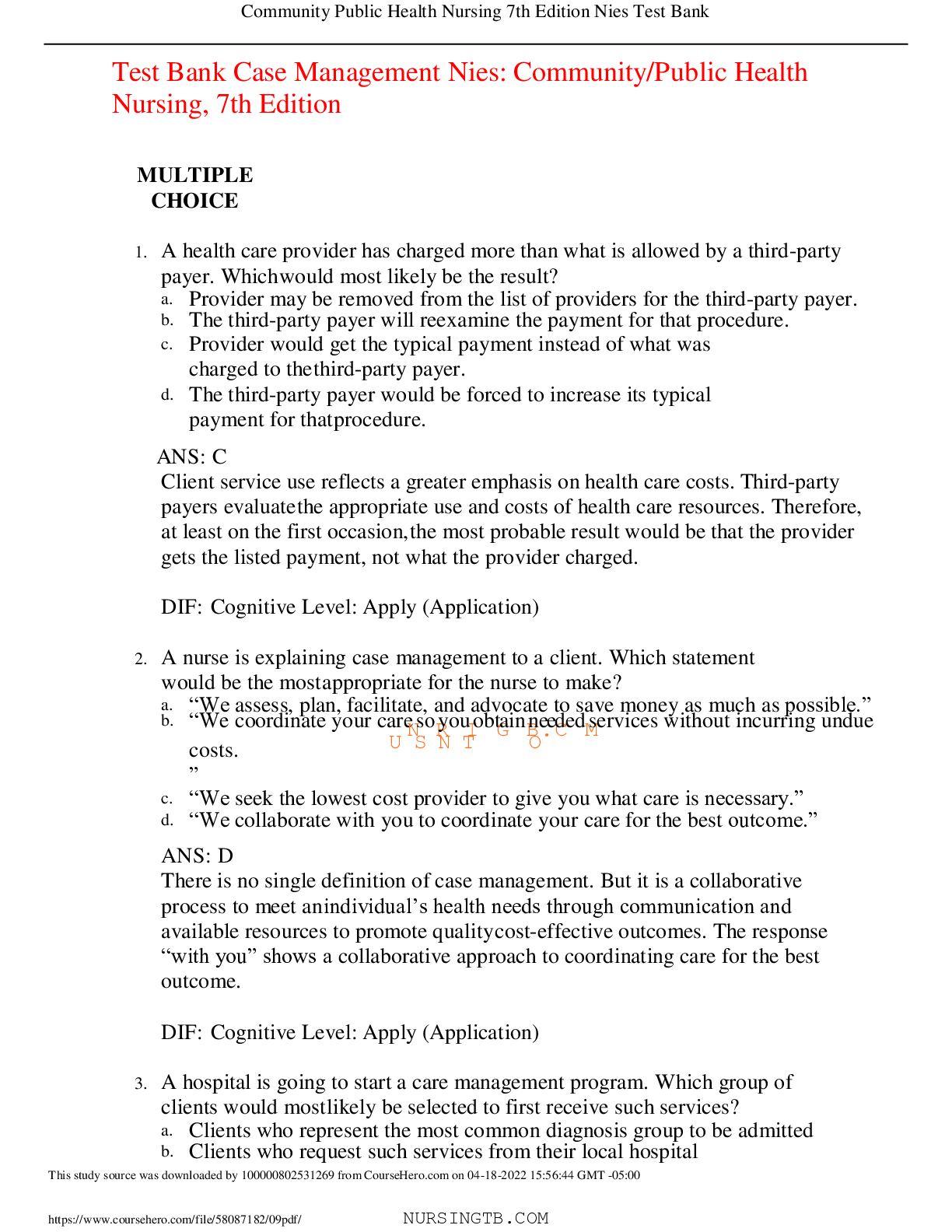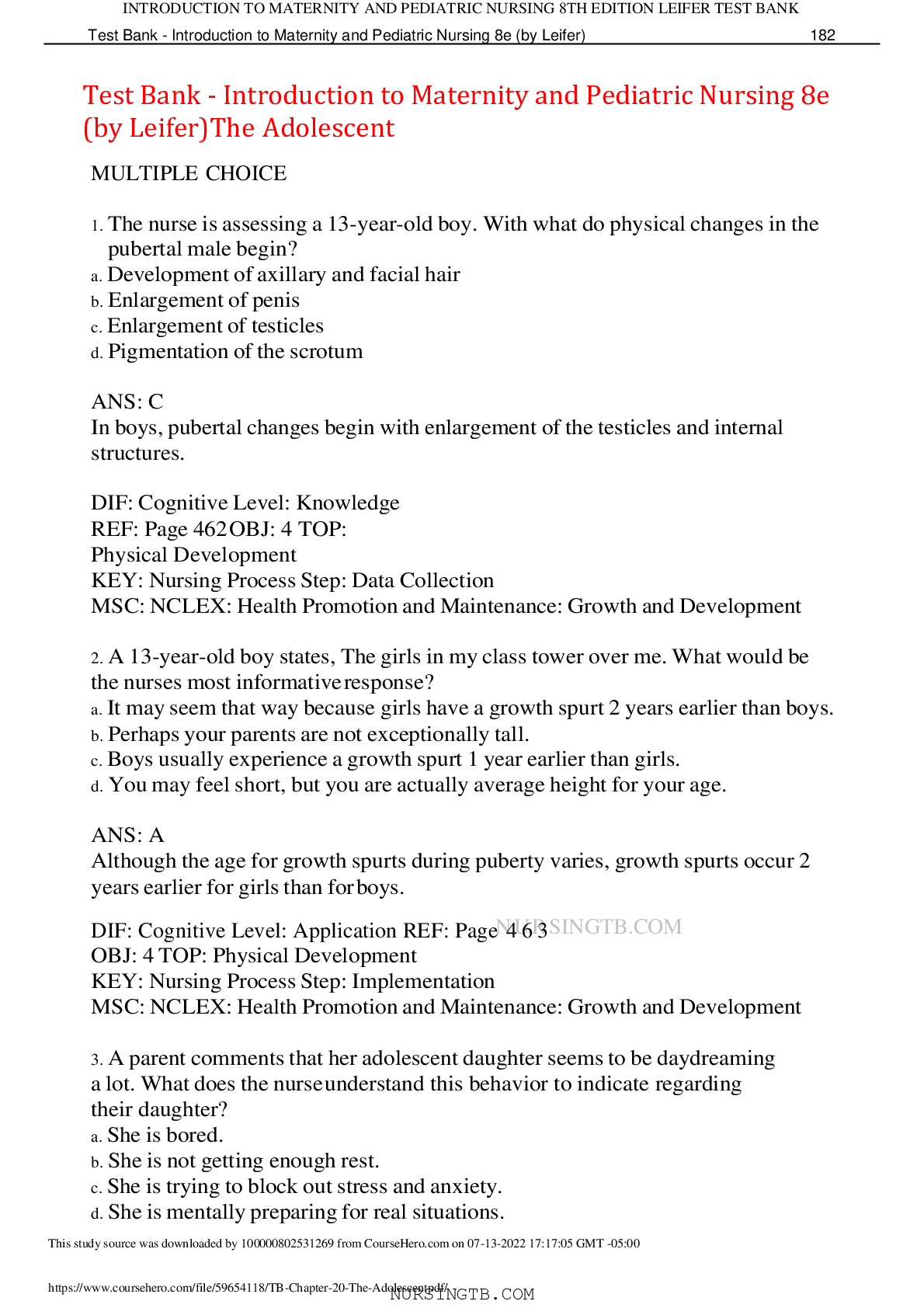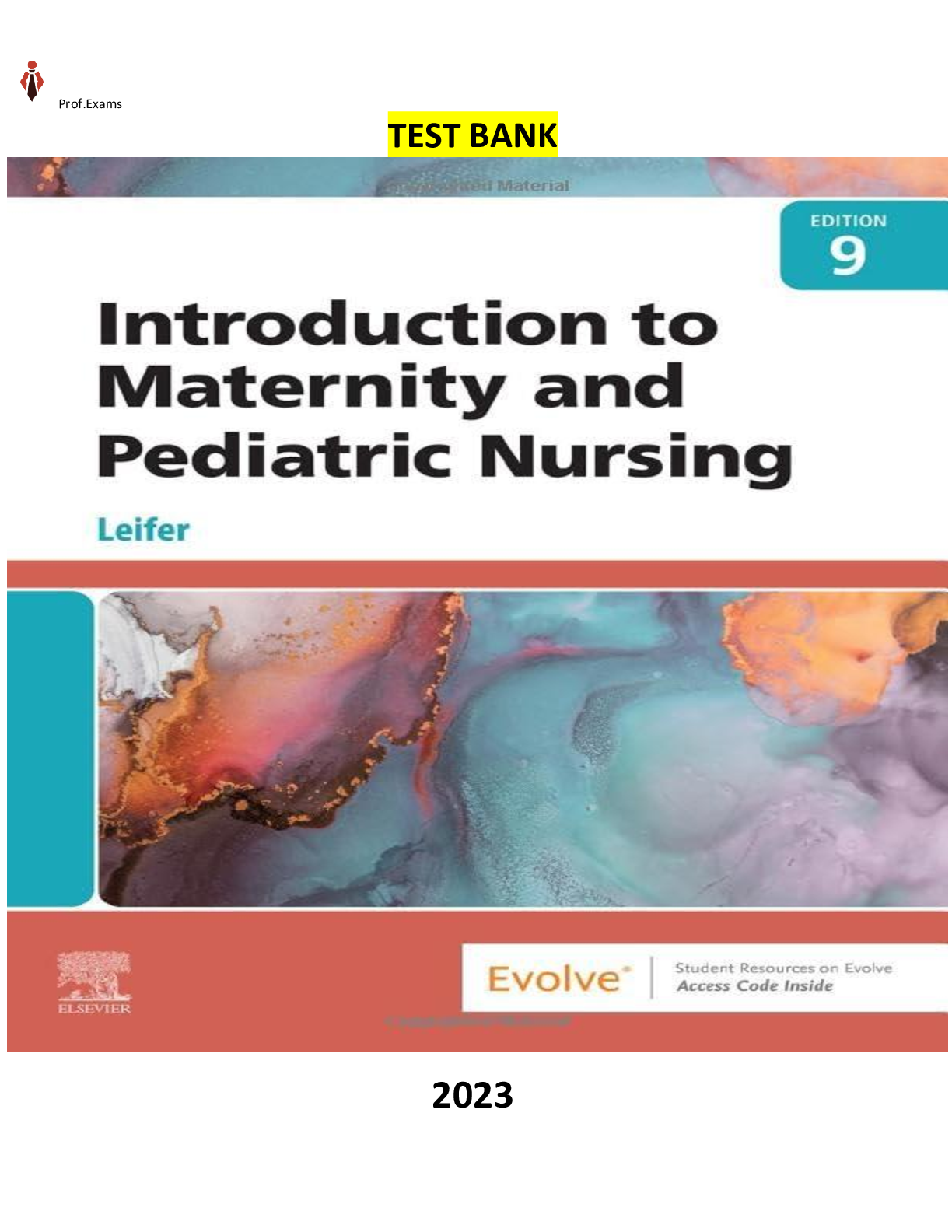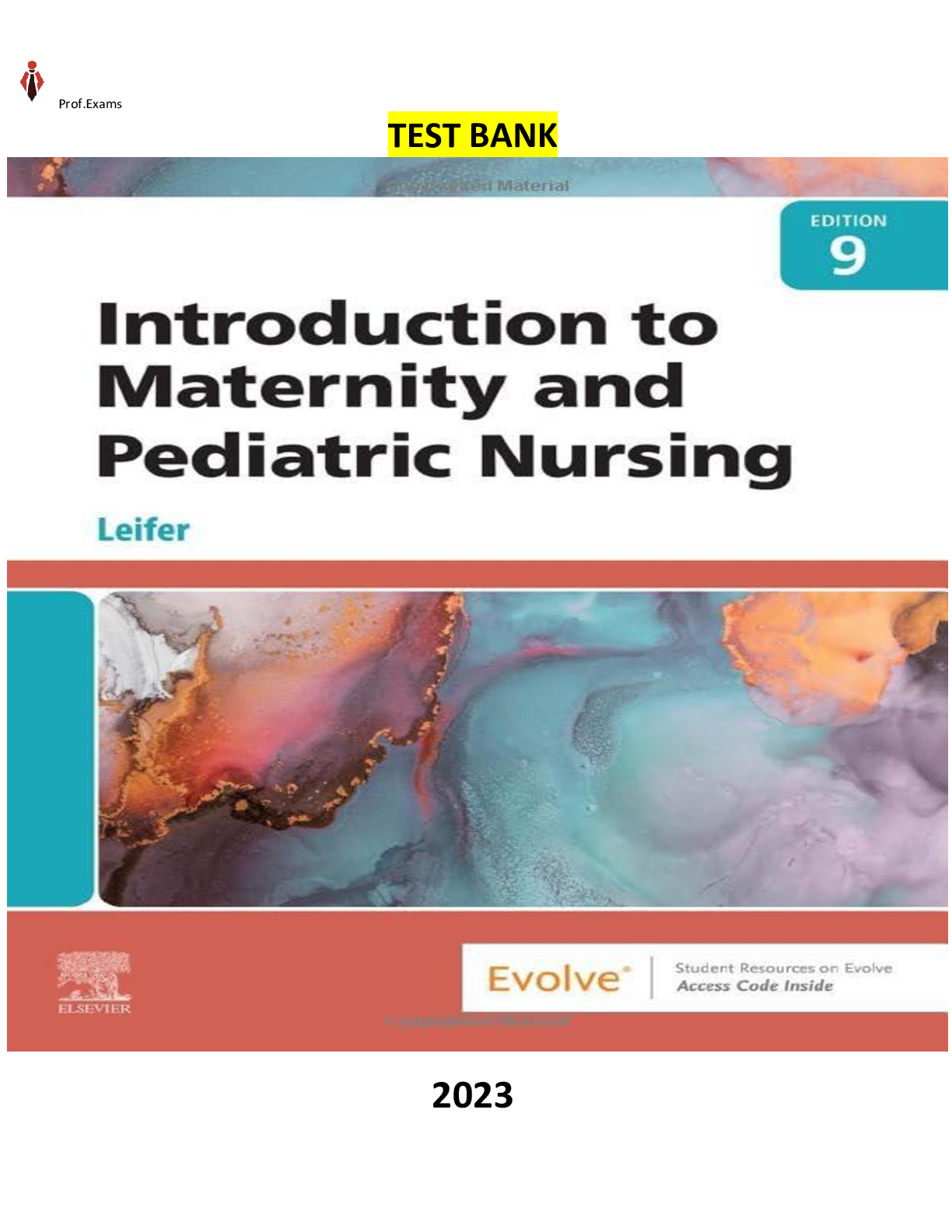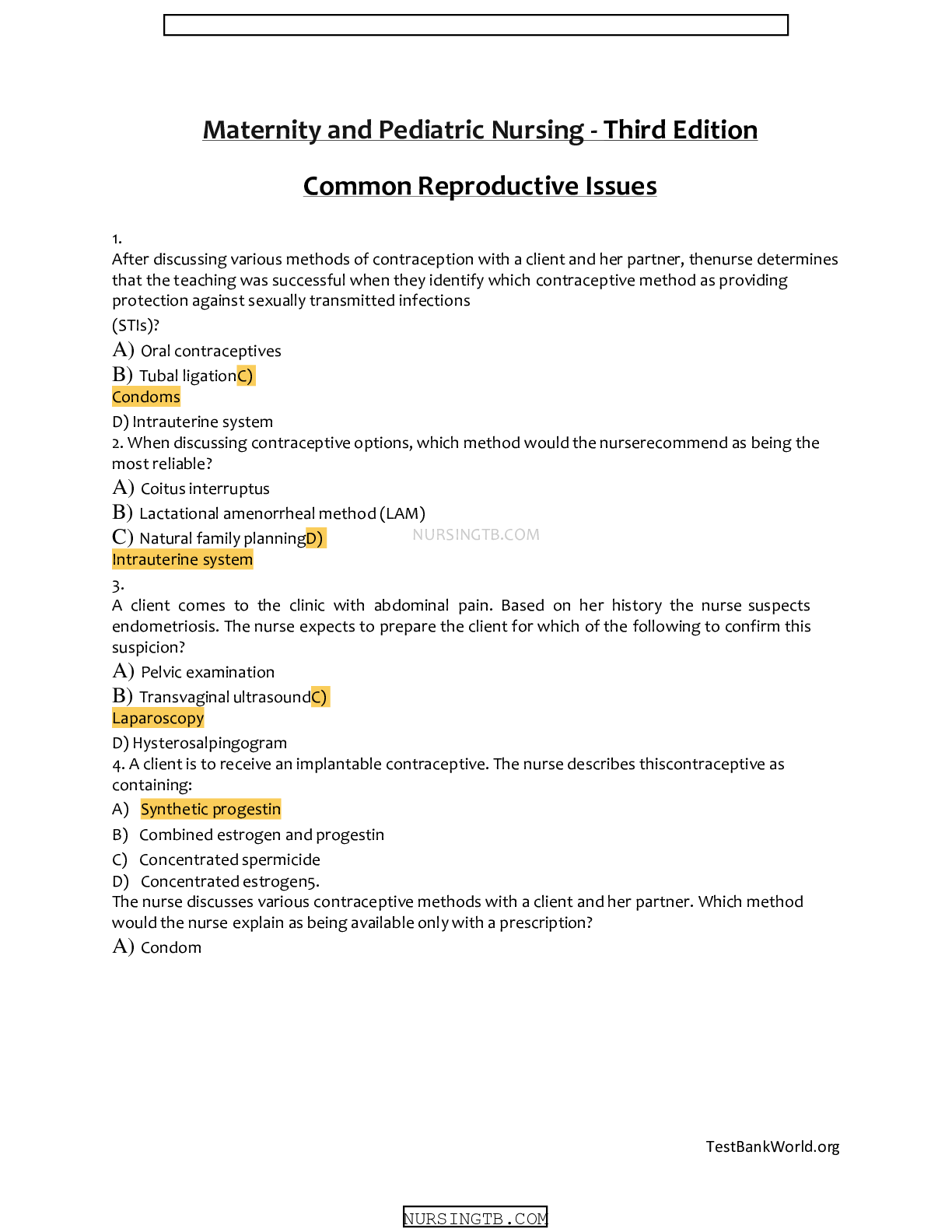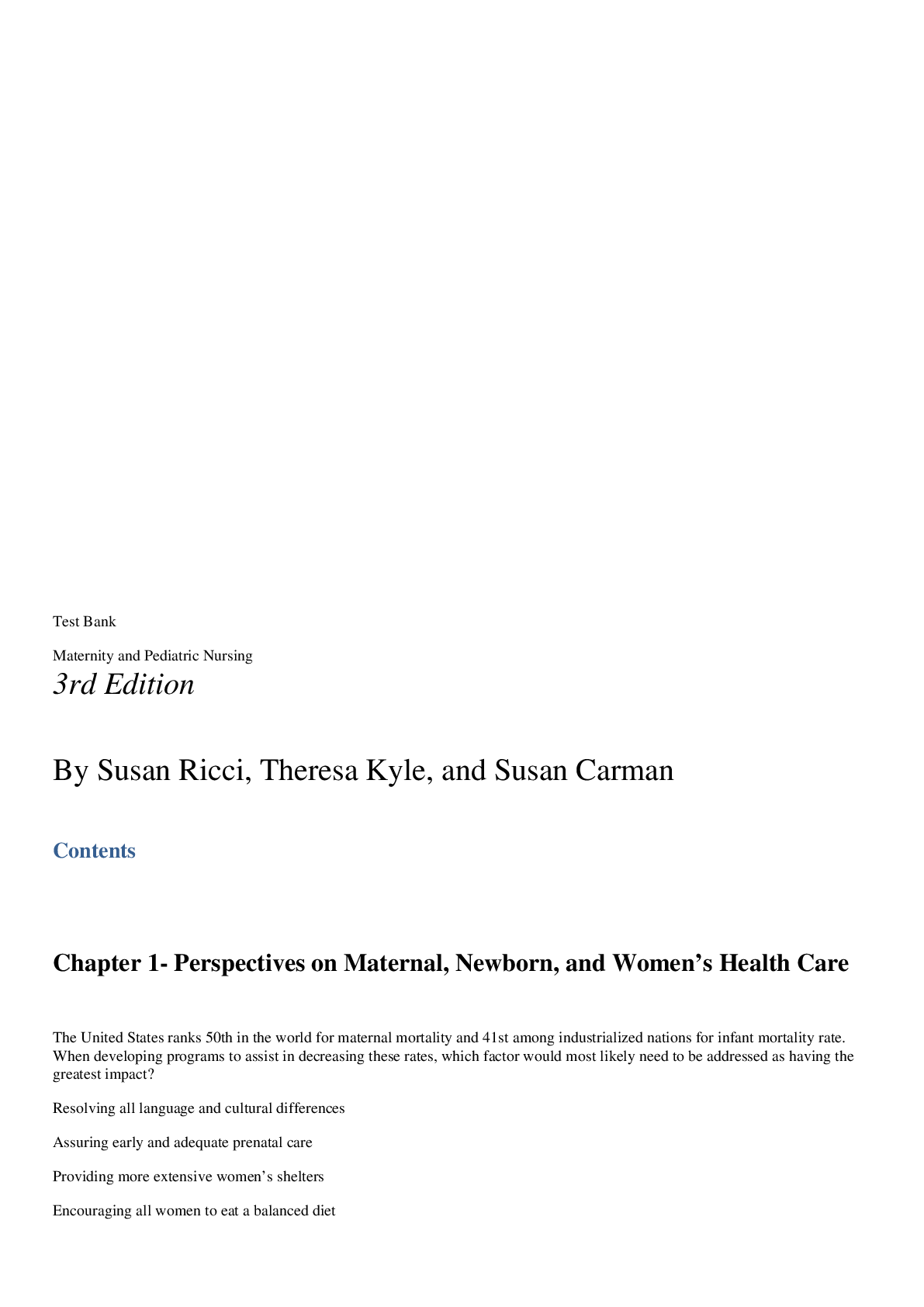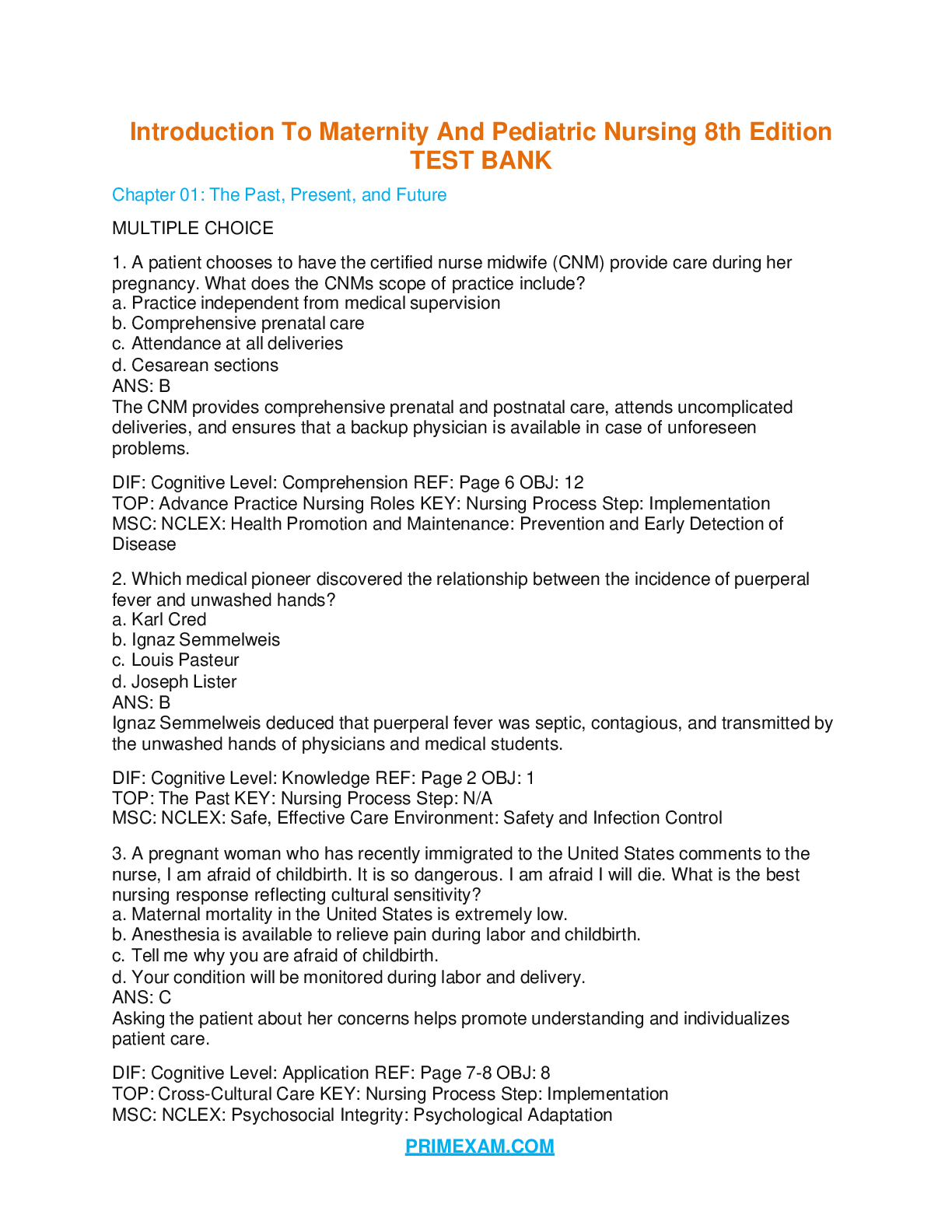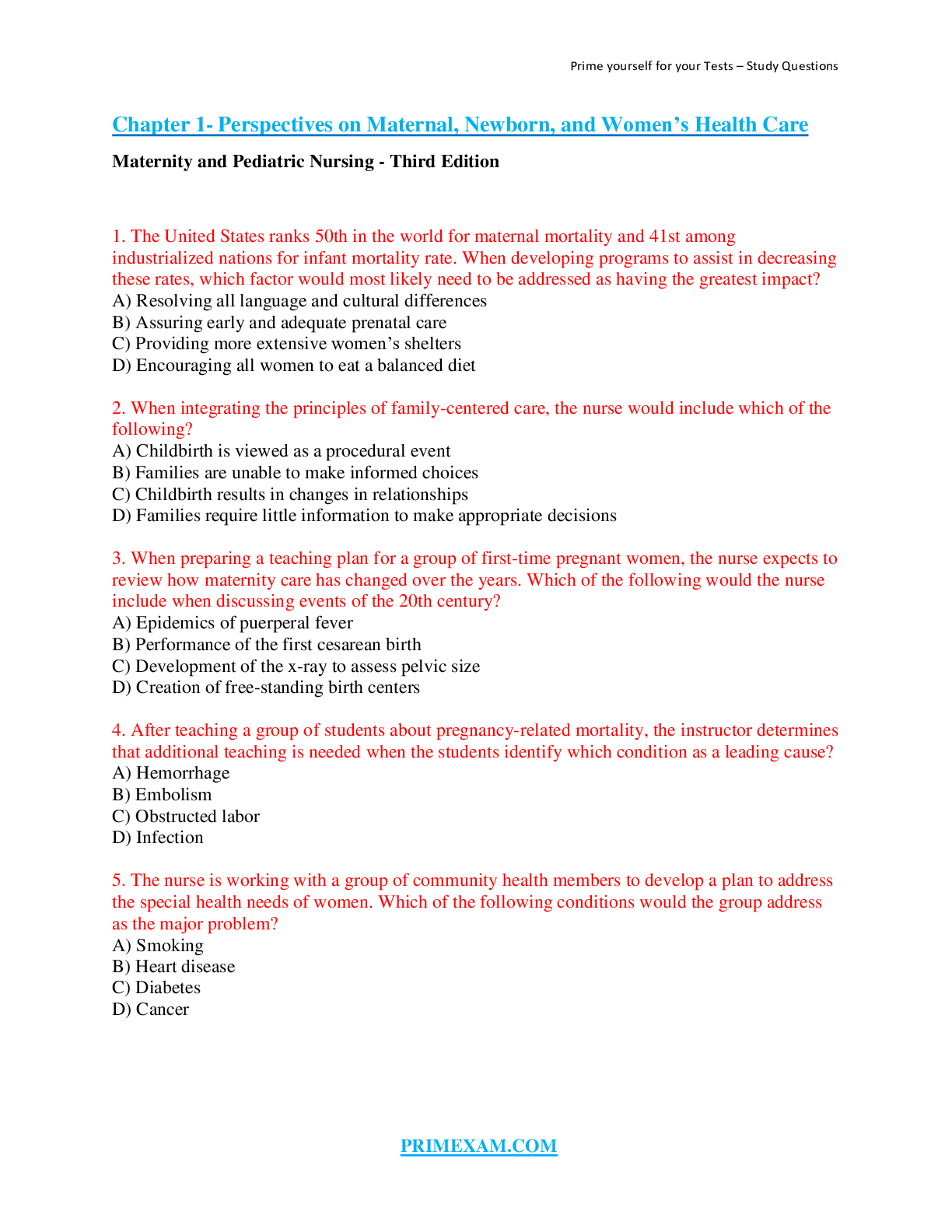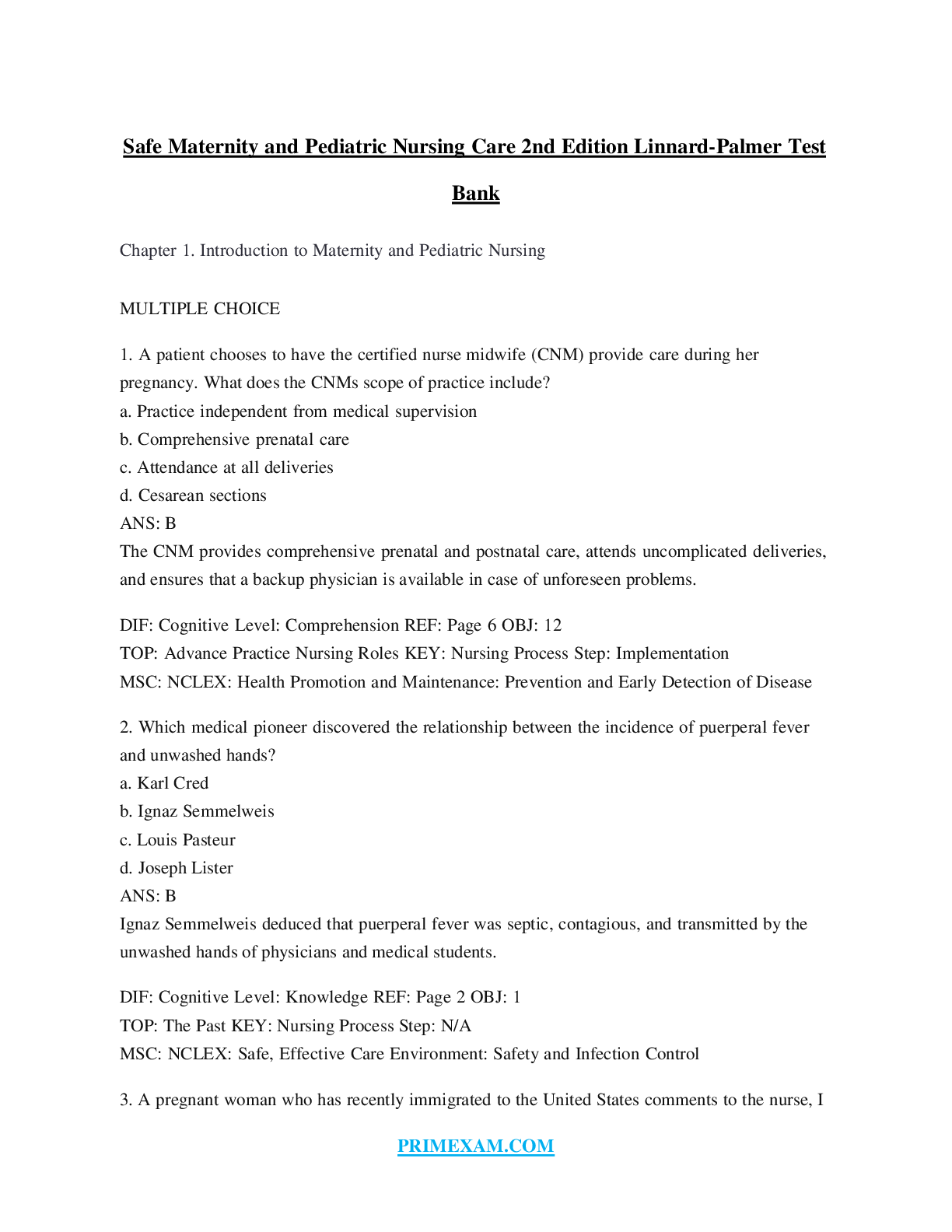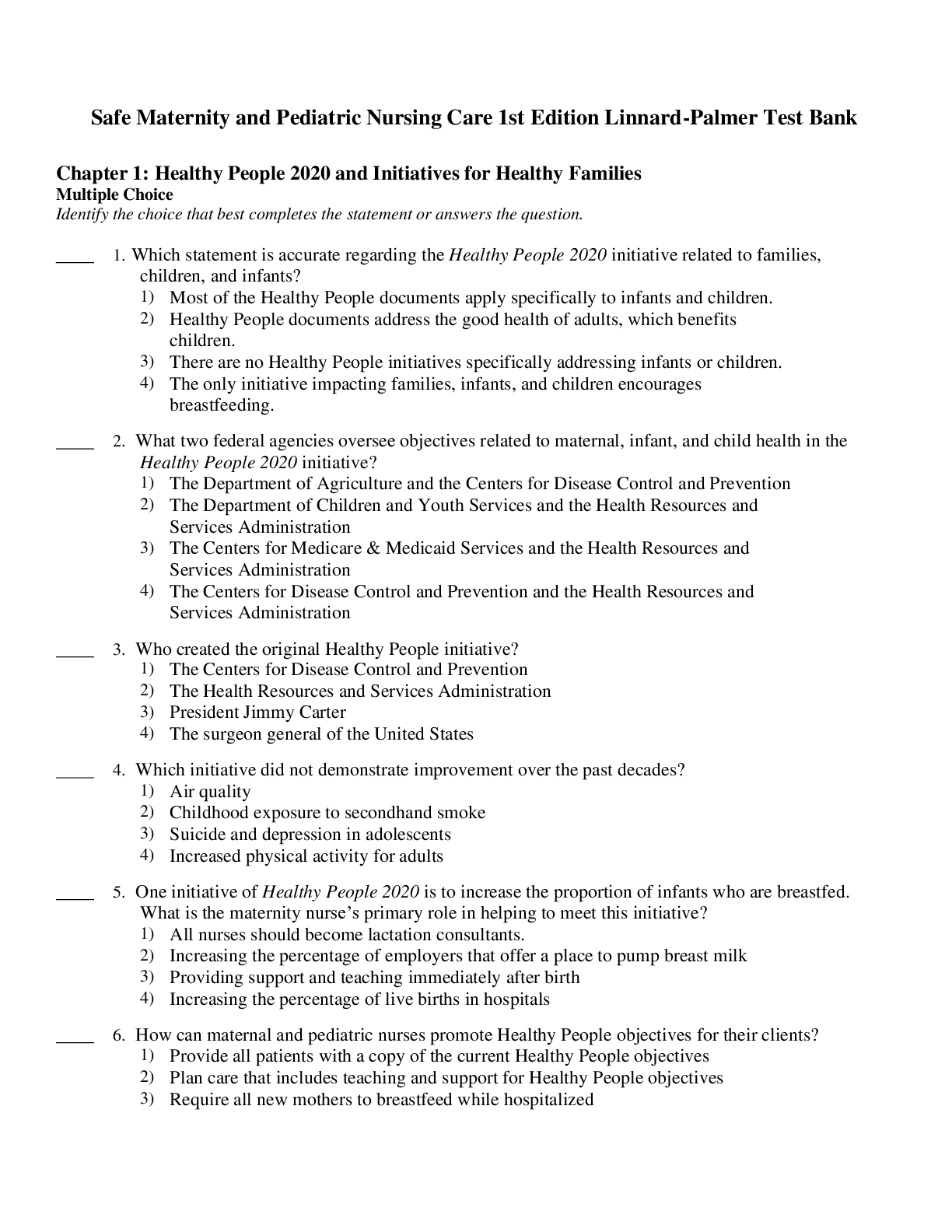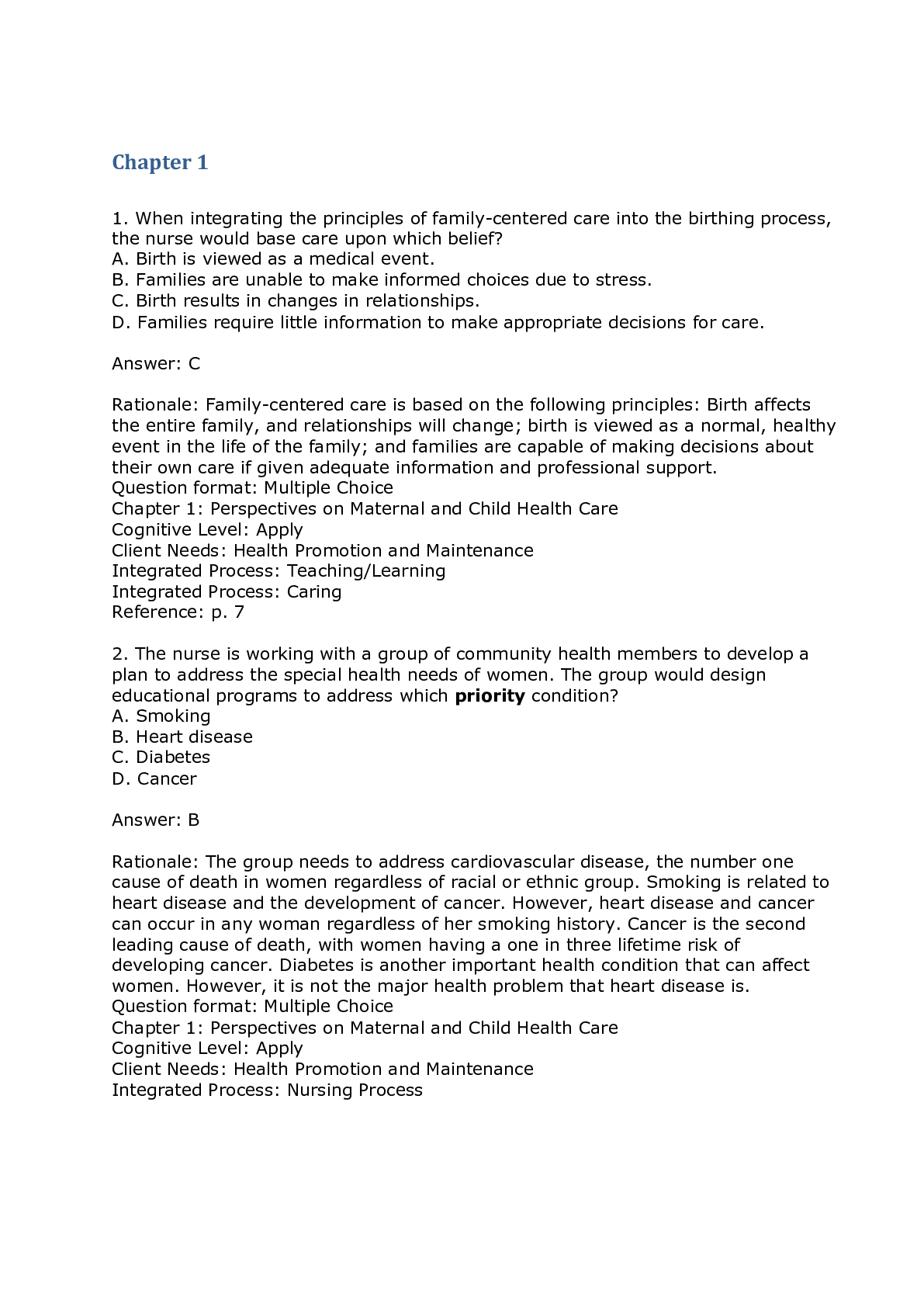*NURSING > TEST BANK > Test Bank - Introduction to Maternity and Pediatric Nursing Fetal Development 8e (by Leifer) (All)
Test Bank - Introduction to Maternity and Pediatric Nursing Fetal Development 8e (by Leifer)
Document Content and Description Below
Test Bank - Introduction to Maternity and Pediatric Nursing Fetal Development 8e (by Leifer) Fetal Development MULTIPLE CHOICE 1. What is the total number of chromosomes contained in a mature s... perm or ovum? a. 22 b. 23 c. 44 d. 46 ANS: B Gametes (sex chromosomes) contain 23 chromosomes. DIF: Cognitive Level: Knowledge REF: Page 33 TOP: Gametogenesis KEY: Nursing Process Step: N/A MSC: NCLEX: Health Promotion and Maintenance: Growth and Development 2. A pregnant woman states, My husband hopes I will give him a boy because we have three girls. What will the nurse explain to this woman? a. The sex chromosome of the fertilized ovum determines the gender of the child. b. When the sperm and ovum are united, there is a 75% chance the child will be a girl. c. When the pH of the female reproductive tract is acidic, the child will be a girl. d. If a sperm carrying a Y chromosome fertilizes an ovum, then a boy is produced. ANS: D When a Y-bearing sperm fertilizes an ovum, a male child is produced. DIF: Cognitive Level: Comprehension REF: Page 35 TOP: Sex Determination KEY: Nursing Process Step: Implementation MSC: NCLEX: Health Promotion and MainteNnaUnRcSe:INGGroTwBt.Ch OanMd Development 3. What is the most common site for fertilization? a. Lower segment of the uterus b. Outer third of the fallopian tube near the ovary c. Upper portion of the uterus d. Area of the fallopian tube farthest from the ovary ANS: B Fertilization takes place in the outer third of the fallopian tube, which is closest to the ovary. DIF: Cognitive Level: Knowledge REF: Page 35 TOP: Fertilization KEY: Nursing Process Step: Implementation MSC: NCLEX: Health Promotion and Maintenance: Growth and Development 4. The embryo is termed a fetus at which stage of prenatal development? a. 2 weeks b. 4 weeks c. 9 weeks d. 16 weeks ANS: C The fetus (third stage of prenatal development) begins at the ninth week and continues until the 40th week of gestation or until birth. DIF: Cognitive Level: Knowledge REF: Page 38 TOP: Prenatal Developmental Milestones KEY: Nursing Process Step: Implementation MSC: NCLEX: Health Promotion and Maintenance: Growth and Development 5. The nurse is reviewing fetal circulation with a pregnant patient and explains that blood circulates through the placenta to the fetus. What vessel(s) carry blood to the fetus? a. One umbilical vein b. Two umbilical veins c. One umbilical artery d. Two umbilical arteries ANS: A The umbilical vein transports richly oxygenated blood from the placenta to the fetus. DIF: Cognitive Level: Knowledge REF: Page 41 TOP: Fetal Circulation KEY: Nursing Process Step: Implementation MSC: NCLEX: Health Promotion and Maintenance: Growth and Development 6. Where is the usual location for implantation of the zygote? a. Upper section of the posterior uterine wall b. Lower portion of the uterus near the cervical os c. Inner third of the fallopian tube near the uterus d. Lateral aspect of the uterine wall ANS: A The zygote usually implants in the upper section of the posterior uterine wall. DIF: Cognitive Level: Knowledge REF: Page 37 TOP: Implantation KEY: Nursing Process Step: N/A MSC: NCLEX: Health Promotion and Maintenance: Growth and Development 7. What is the embryonic membrane that contains fingerlike projections on its surface, which attach to the uterine wall? a. Amnion b. Yolk sac c. Chorion d. Decidua basalis NURSINGTB.COM ANS: C The chorion is a thick membrane with fingerlike projections (villi) on its outermost surface. DIF: Cognitive Level: Knowledge REF: Page 37 TOP: Accessory Structures of Pregnancy KEY: Nursing Process Step: N/A MSC: NCLEX: Health Promotion and Maintenance: Growth and Development 8. Which hormone is responsible for converting the endometrium into decidual cells for implantation? a. Estrogen b. Human chorionic gonadotropin c. Human placental lactogen d. Progesterone ANS: D At high levels, progesterone maintains the endometrial lining for implantation of the zygote. DIF: Cognitive Level: Knowledge REF: Page 41 TOP: Placenta KEY: Nursing Process Step: N/A MSC: NCLEX: Health Promotion and Maintenance: Growth and Development 9. A patient asks the nurse when her infants heart will begin to pump blood. What will the nurse reply? a. By the end of week 3 b. Beginning in week 8 c. At the end of week 16 d. Beginning in week 24 ANS: A The fetal heart begins to pump by week 3 of gestation. DIF: Cognitive Level: Knowledge REF: Page 38 TOP: Prenatal Development KEY: Nursing Process Step: N/A MSC: NCLEX: Health Promotion and Maintenance: Growth and Development 10. What organ does the ductus venosus shunt blood away from in fetal circulation? a. Liver b. Heart c. Lungs d. Kidneys ANS: A Fetal blood bypasses the liver through the ductus venosus by carrying blood directly to the inferior vena cava. DIF: Cognitive Level: Knowledge REF: Page 41 TOP: Prenatal Development KEY: Nursing Process Step: N/A MSC: NCLEX: Health Promotion and Maintenance: Growth and Development 11. What complication can result from untreated respiratory distress in the newborn? a. Esophageal atresia b. Gastric dilation c. Cold stress d. Reopening of the foramen ovale ANS: D Respiratory distress can cause increased pressure in the right ventricle, causing reopening of the foramen ovale NURSINGTB.COM DIF: Cognitive Level: Comprehension REF: Page 42 TOP: Fetal Circulation KEY: Nursing Process Step: Implementation MSC: NCLEX: Health Promotion and Maintenance: Growth and Development 12. During an ultrasound, two amnions and two placentas are observed. What will be the most likely result of this pregnancy? a. Dizygotic twins b. Monozygotic twins c. Conjoined twins d. High birth-weight twins ANS: A Dizygotic twins always have two amnions and two chorions (placentas). DIF: Cognitive Level: Comprehension REF: Page 44 TOP: Multifetal Pregnancy KEY: Nursing Process Step: Data Collection MSC: NCLEX: Health Promotion and Maintenance: Growth and Development 13. A woman who is 25 weeks pregnant asks the nurse what her fetus looks like. What does the nurse explain is one physical characteristic present in a 25-week-old fetus? a. Lanugo covering the body b. Constant motion c. Skin that is pink and smooth d. Eyes that are closed ANS: A By 25 weeks, the body of the fetus is covered with lanugo, the eyes are open, the skin is wrinkled, and the fetus has definite periods of movement and sleeping. DIF: Cognitive Level: Comprehension REF: Page 39 OBJ: 5 TOP: Prenatal Development KEY: Nursing Process Step: Implementation MSC: NCLEX: Health Promotion and Maintenance: Growth and Development 14. At what point in prenatal development do the lungs begin to produce surfactant? a. 17 weeks b. 20 weeks c. 25 weeks d. 30 weeks ANS: C During week 25, the alveoli begin to produce surfactant, which enables the alveoli to stay open for adequate lung oxygenation to occur. DIF: Cognitive Level: Knowledge REF: Page 39 OBJ: 5 TOP: Prenatal Development KEY: Nursing Process Step: N/A MSC: NCLEX: Health Promotion and Maintenance: Growth and Development 15. A woman missed her menstrual period 1 week ago and has come to the doctors office for a pregnancy test. Which placental hormone is measured in pregnancy tests? a. Progesterone b. Estrogen c. Human chorionic gonadotropin d. Human placental lactogen ANS: C Human chorionic gonadotropin is the basis for most pregnancy tests. It is detectable in maternal blood as soon as implantation occurs, usually 7 to 9 days after fertilization. NURSINGTB.COM DIF: Cognitive Level: Knowledge REF: Page 41 TOP: Accessory Structures of Pregnancy KEY: Nursing Process Step: Data Collection MSC: NCLEX: Health Promotion and Maintenance: Growth and Development 16. When preparing to teach a class about prenatal development, the nurse would include information about folic acid supplementation. What is folic acid known to prevent? a. Congenital heart defects b. Neural tube defects c. Mental retardation d. Premature birth ANS: B It is now known that folic acid supplements can prevent neural tube defects such as spina bifida. DIF: Cognitive Level: Comprehension REF: Page 39 TOP: Prenatal Development KEY: Nursing Process Step: Planning MSC: NCLEX: Health Promotion and Maintenance: Growth and Development 17. The nurse is educating a class of expectant parents about fetal development. What is considered fetal age of viability? a. 14 weeks b. 20 weeks c. 25 weeks d. 30 weeks ANS: B By 20 weeks of gestation, the lungs have matured enough for the fetus to survive outside the uterus (age of viability). DIF: Cognitive Level: Knowledge REF: Page 39 TOP: Prenatal Developmental Milestones KEY: Nursing Process Step: N/A MSC: NCLEX: Health Promotion and Maintenance: Growth and Development 18. The nurse is presenting a conference on gene dominance. What does the nurse report as the percentage of children carrying the dominant gene if one parent has a dominant gene and the other parent does not? a. 10% b. 25% c. 50% d. 100% ANS: C If one parent has a dominant trait and the other does not, then 50% of the children will inherit the trait. DIF: Cognitive Level: Comprehension REF: Page 36 TOP: Dominant Traits KEY: Nursing Process Step: Implementation MSC: NCLEX: Health Promotion and Maintenance: Growth and Development 19. The nurse explains that the birth weight of monozygotic twins is frequently below average. What is the most likely cause? a. Inadequate space in the uterus b. Inadequate blood supply c. Inadequate maternal health d. Inadequate placental nutrition ANS: D The single placenta may not be able to provide adequate nutrition to two fetuses. DIF: Cognitive Level: Comprehension REF: Page 44 TOP: Low Birth-weight Twins KEY: NursingNPUroRcSeIsNsGSTteBp.:CIOmMplementation MSC: NCLEX: Health Promotion and Maintenance: Growth and Development 20. The school nurse is counseling a group of adolescent girls. What does the nurse explain about sperm ejaculated near the cervix? a. They are destroyed by the acidic pH of the vagina. b. They survive up to 5 days and can cause pregnancy. c. They lose their motility in about 12 hours after intercourse. d. They are usually pushed out of the vagina by the muscular action of the vaginal wall. ANS: B Sperm ejaculated near the cervix can survive up to 5 days and cause pregnancy even before ovulation. DIF: Cognitive Level: Comprehension REF: Page 35 TOP: Fertilization KEY: Nursing Process Step: Implementation MSC: NCLEX: Health Promotion and Maintenance: Growth and Development 21. What does the nurse explain can affect the survival of the X- and Y-bearing sperm after intercourse? a. Age b. Estrogen level c. Body temperature d. Level of feminine hygiene ANS: B Estrogen levels and the pH of the female reproductive tract can affect the survival of the X- and Y-bearing sperm as well as their motility. DIF: Cognitive Level: Knowledge REF: Page 35 TOP: Fertilization KEY: Nursing Process Step: Implementation MSC: NCLEX: Health Promotion and Maintenance: Growth and Development 22. Of what is the normal umbilical cord comprised? a. 1 artery carrying blood to the fetus and 1 vein carrying blood away from the fetus b. 1 artery carrying blood to the fetus and 2 veins carrying blood away from the fetus c. 2 arteries carrying blood away from the fetus and 1 vein carrying blood to the fetus d. 2 arteries carrying blood to the fetus and 2 veins carrying blood away from the fetus ANS: C The umbilical cord is comprised of 2 arteries carrying blood away from the fetus and 1 vein carrying blood to the fetus. DIF: Cognitive Level: Knowledge REF: Page 41 TOP: Fetal Circulation KEY: Nursing Process Step: N/A MSC: NCLEX: Health Promotion and Maintenance: Growth and Development 23. What part of the fetal body derives from the mesoderm? a. Nails b. Oil glands c. Muscles d. Lining of the bladder ANS: C The mesoderm is responsible for the development of muscles. Nails and oil glands derive from the ectoderm. The lining of the bladder derives from the endoderm. DIF: Cognitive Level: Knowledge REF: Page 37 OBJ: 4 TOP: Embryonic development KEY: Nursing Process Step: N/A MSC: NCLEX: Health Promotion and Maintenance: Growth and Development 24. A couple just learned they are expecting their first child and are curious if they are having a boy or a girl. At what point of development can the couple fNirUstReSxINpeGcTt Bto.CseOeMthe sex of their child on ultrasound? a. 4 weeks gestational age b. 6 weeks gestational age c. 10 weeks gestational age d. 16 weeks gestational age ANS: C The fetal period begins at the ninth week, and by the tenth week the external genitalia are visible to ultrasound examination. DIF: Cognitive Level: Knowledge REF: Page 39 TOP: Fetal Development KEY: Nursing Process Step: Data Collection MSC: NCLEX: Health Promotion and Maintenance: Growth and Development MULTIPLE RESPONSE 25. A nurse is teaching a lesson on fetal development to a class of high school students and explains the primary germ layers. What are the germ layers? (Select all that apply.) a. Ectoderm b. Endoderm c. Mesoderm d. Plastoderm e. Blastoderm ANS: A, B, C The zygote transforms its embryonic disc into three layers: the ectoderm, the mesoderm, and the endoderm. DIF: Cognitive Level: Knowledge REF: Page 37 OBJ: 4 TOP: Primary Germ Layers KEY: Nursing Process Step: Implementation MSC: NCLEX: Health Promotion and Maintenance: Growth and Development 26. What are the functions of amniotic fluid? (Select all that apply.) a. Maintaining an even temperature b. Impeding excessive fetal movement c. Lubricating fetal skin d. Acting as a reservoir for nutrients e. Acting as a cushion for the fetus ANS: A, E The amniotic fluid provides maintenance of even temperature; prevents amnion from adhering to fetal skin; allows buoyancy, symmetrical growth, and fetal movement; and acts as a cushion for the fetus. Although the fetus does swallow amniotic fluid, it has no nutritional value. DIF: Cognitive Level: Knowledge REF: Page 37 OBJ: 6 TOP: Amniotic Fluid KEY: Nursing Process Step: Implementation MSC: NCLEX: Health Promotion and Maintenance: Growth and Development 27. A patient at the obstetric office has just learned she is pregnant with dizygotic twins. What facts will the nurse include when educating this patient? (Select all that apply.) a. Dizygotic twins are the same sex. b. Dizygotic twins share a placenta. c. Dizygotic pregnancies tend to repeat in families. d. Dizygotic twins have separate chorions. e. Dizygotic twin incidence decreases with maternal age. ANS: C, D Dizygotic twins tend to repeat in families and have separate chorions. They can be the same sex or different sexes and have their own placenta. Incidence iNnUcrReSasINesGwTiBth.CmOaMternal age. DIF: Cognitive Level: Comprehension REF: Page 44 TOP: Dizygotic Twins KEY: Nursing Process Step: Data Collection MSC: NCLEX: Health Promotion and Maintenance: Growth and Development COMPLETION 28. The nurse explains that prior to fertilization each cell is reduced from 46 chromosomes to 23 chromosomes This is referred to as the number. ANS: haploid When each cell reduces its chromosomes from 46 to 23, it is called the haploid number. DIF: Cognitive Level: Knowledge REF: Page 34 TOP: Haploid Number KEY: Nursing Process Step: Implementation MSC: NCLEX: Health Promotion and Maintenance: Growth and Development 29. The component of development that programs the genetic code into the nucleus of the cell is . ANS: DNA The DNA programs the genetic code to the nucleus of the cell to be replicated. DIF: Cognitive Level: Knowledge REF: Page 33 OBJ: 4 TOP: DNA KEY: Nursing Process Step: N/A MSC: NCLEX: Health Promotion and Maintenance: Growth and Development 30. The vessels comprising the umbilical cord are cushioned and protected by a substance called . ANS: Whartons jelly Whartons jelly is a substance in the umbilical cord that cushions and protects the vessels. DIF: Cognitive Level: Knowledge REF: Page 41 TOP: Fetal Circulation KEY: Nursing Process Step: N/A MSC: NCLEX: Health Promotion and Maintenance: Growth and Development 31. The normal volume of amniotic fluid is approximately mL at 37 weeks gestation. ANS: 1000 The volume of amniotic fluid steadily increases from about 30 mL at 10 weeks of pregnancy to 350 mL at 20 weeks. The volume of fluid is about 1000 mL at 37 weeks. In the latter part of pregnancy the fetus may swallow up to 400 mL of amniotic fluid per day and normally excretes urine into the fluid. DIF: Cognitive Level: Knowledge REF: Page 37 TOP: Amniotic Fluid KEY: Nursing Process Step: Data Collection MSC: NCLEX: Health Promotion and Maintenance: Growth and Development 32. Organize the developmental stages in the correct order. Put a comma and space between each answer choice (a, b, c, d, etc.) a. Fetus b. Zygote c. Embryo d. Blastocyst e. Morula ANS: B, E, D, C, A NURSINGTB.COM The development follows these stages: zygote, morula, blastocyst, embryo, and fetus. DIF: Cognitive Level: Comprehension REF: Page 36 TOP: Fetal Development KEY: Nursing Process Step: N/A MSC: NCLEX: Health Promotion and Maintenance: Growth and Development 33. Put the embryonic/fetal characteristics in the correct order of occurrence from week 3 to week 36 of gestation. Put a comma and space between each answer choice (a, b, c, d, etc.) a. Subcutaneous fat is present. b. Bone marrow forms blood cells. c. Spinal cord and brain appear. d. Skull and jaw ossify. e. Neural tube closes. ANS: C, E, D, B, A Primitive spinal cord and brain appear at 3 weeks. Neural tube closes at 4 weeks. Skull and jaw ossify at 6 weeks. Spleen stops forming blood cells and bone marrow takes over at 29 weeks. Subcutaneous fat is present at 36 weeks. DIF: Cognitive Level: Comprehension REF: Page 37 OBJ: 5 TOP: Fetal Development KEY: Nursing Process Step: Data Collection MSC: NCLEX: Health Promotion and Maintenance: Growth and Development NURSINGTB.COM [Show More]
Last updated: 11 months ago
Preview 1 out of 17 pages

Reviews( 0 )
Document information
Connected school, study & course
About the document
Uploaded On
Jul 09, 2022
Number of pages
17
Written in
Additional information
This document has been written for:
Uploaded
Jul 09, 2022
Downloads
0
Views
39













